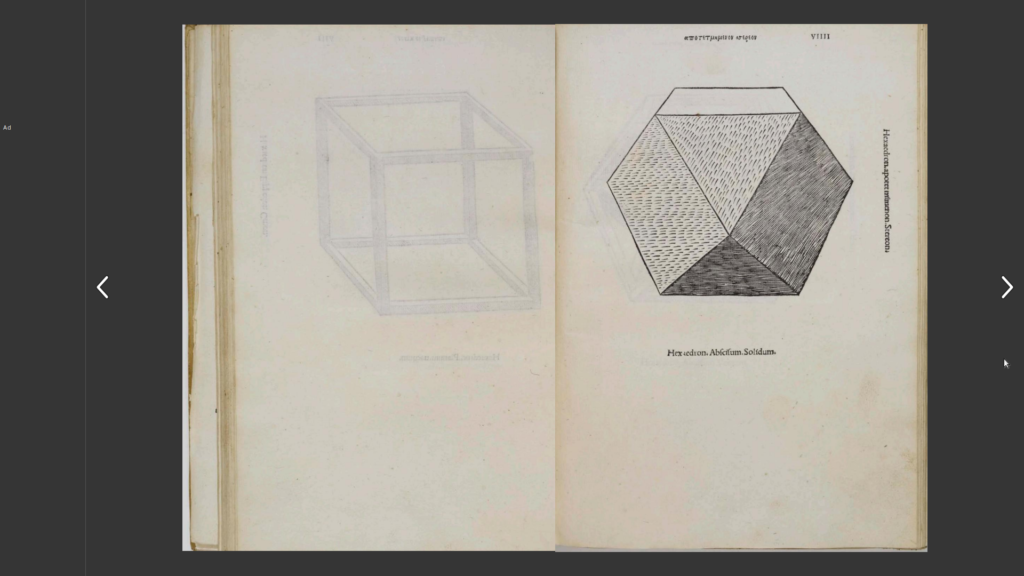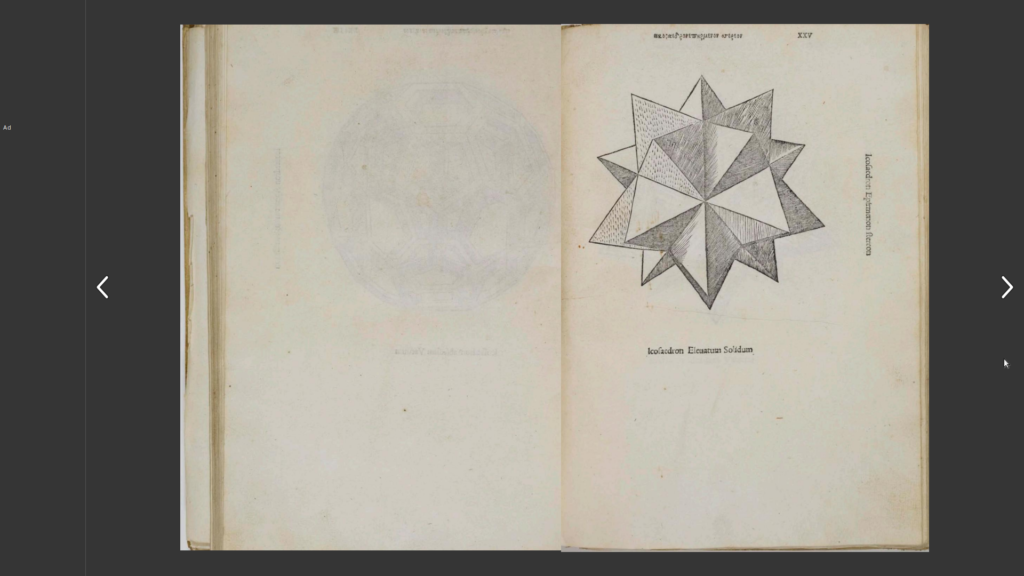In the late 15th Century the Italian mathematician and Franciscan friar, Luca Pacioli, published a book on geometry, perspective, and achitecture entitled Divina Proportione — the title a reference to the divine ratio. Having the misfortune of writing over five hundred years ago, he did not have access to LaTex or any kind of similar mathematical markup language, and indeed the typesetting had to be done the old fashioned way. He did however enjoy the services of Leonardo da Vinci for producing the illustrations. Which is a considerable consolation. (You can browse an original copy online.)
These illustrations were the only work published in Leonardo’s lifetime — his celebrated notebooks coming to light posthumously. The illustrations cover variations of the Platonic solids, and in what would have been at the time an innovative approach to mathematical visualization, Leonardo not only drew them as solids, but also as hollowed out skeletons. This aptitude for conveying the three dimensional on the page can also be seen in his famous and influential anatomy sketches from his notebooks.
Being, quite literally, a Renaissance man, mathematics figured among Leonardo’s many interests, often overlapping with his engineering, scientific, and artistic pursuits. Although it has been claimed that Leonardo employed the golden ratio in his art, this seems unlikely. Leonardo documented his process and thinking in his notebooks, often expounding in great length, composing books that would go unpublished, yet there is no mention of him claiming to employ the ratio in his composition.
We do however have extensive evidence for Leonardo’s obsessive hunt to square the circle:
He filled his notebooks with shaded drawings in which he overlapped two half-circles and then created triangles and rectangles that had the same area as the resulting crescents. Year after year, he relentlessly pursued ways to create circular shapes with areas equivalent to triangles and rectangles, as if addicted to the game. Though he never gave the precise dates of any milestones he reached when making a painting, he treated these geometric studies as if each little success was a moment in history worthy of a notarial record. One night he wrote momentously, “Having for a long time searched to square the angle to two equal curves…now in the year 1509 on the eve of the Calends of May [April 30] I have found the solution at the 22nd hour on Sunday.
Leonardo da Vinci, The Biography — Walter Isaacson.
I think all of us mathematicians should take a great deal of comfort in how universal an experience it is to arrive at such false dawns. Kenneth Clarke has commented that the pages Leonardo devotes to these mathematical efforts are essentially of no value — neither to the mathematician nor the art historian. It is worth bearing in mind that most mathematical notebooks are mostly full of ideas that are wrong, incorrectly formulated, or badly expressed.
As the above discussion may suggest, I am currently in the middle of reading my way through Walter Isaacson’s biography of Leonardo da Vinci. Leonardo is a towering and influential cultural figure that it is easy to look over how little you really know about him. Not only the man, but also his actual work. Certainly, you recognize a handful of his paintings on sight, and you may also be aware that he designed unworkable helicopters and impractical war machines in his notebooks, but unless you have taken an art history course (I have not) you wouldn’t know why his artwork was really so remarkable, or indeed appreciate the broad scope of what can be found in his notebooks.
You might believe a well cultured individual would have an appreciation for the works of the Renaissance master. That this hypothetical being could walk into the Louvre, have a gander at the Mona Lisa, and they would experience a whole bunch of appreciation. But I don’t think this hypothetical “well cultured” individual exists. Indeed I would argue that a well cultured individual walking around an art gallery is essentially going in to be overwhelmed. If you spend any time looking at the Renaissance art you actually find yourself deep inside the uncanny valley. This might seem obvious, but we’re used to photographs so our sense of what is real is fundamentally adjusted.
All the techniques that Leonardo developed are available to artists today — perspective, understanding light and shadow, the sfumato painting techniques. And then there are all the modern tools and art supplies. Then there is what is being depicted itself: scenes from biblical narratives dressed up in a Renaissance setting. So the scenes are weird, the setting is weird, the people look weird. I want to reiterate that point. Looking at people in renaissance paintings is often like looking at computer generated special effects from ten or twenty years ago. The comparison is very apt. The preoccupations of a CGI artist are actually very similar to what you’ll find Leonardo wrestling with in his notebooks.
It is not that there isn’t much to appreciate in these works of art — I’ve certainly enjoyed reading Isaacson’s biography. But I think the person who wanders around an art gallery with a proper sense of appreciation is really just a certain kind of nerd. Like the rest of us.





